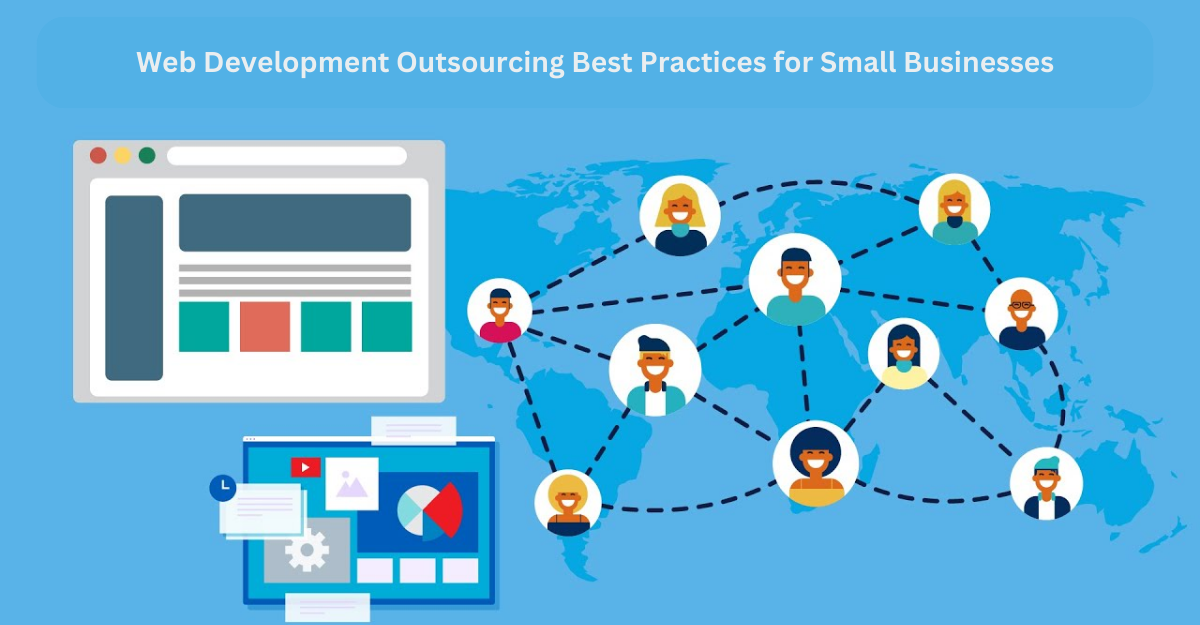Overview of web development outsourcing and its significance for small businesses
In today’s digital age, having a robust online presence is paramount for business success. Small businesses, however, often face resource constraints that make it challenging to create and maintain an effective website. This is where web development outsourcing comes into play, offering an array of benefits for small businesses. Let’s delve into an overview of web development outsourcing and its significance:
What is Web Development Outsourcing?
Web development outsourcing involves contracting external experts or agencies to handle the design, development, and maintenance of a company’s website. Instead of maintaining an in-house web development team, small businesses can leverage the expertise of specialists in web development.
The Significance for Small Businesses:
- Cost-Efficiency: Small businesses typically operate on tight budgets. Outsourcing web development eliminates the need for hiring and training in-house developers, reducing labor costs and allowing businesses to allocate resources more effectively.
- Access to Expertise: Web development firms specialize in creating websites and web applications. By outsourcing, small businesses gain access to a team of professionals with diverse skills and experience, ensuring their project benefits from the latest industry knowledge.
- Time Savings: Building a website from scratch can be a time-consuming endeavor. Outsourcing accelerates the development process, enabling small businesses to establish their online presence more quickly.
- Focus on Core Operations: Outsourcing web development allows small businesses to concentrate on their core competencies and strategic growth initiatives. It alleviates the burden of managing web-related tasks, enabling a more streamlined operation.
- Scalability: Small businesses can tailor their web development efforts to their specific needs. Whether it’s a one-time project or ongoing support, outsourcing offers scalability and flexibility.
- Reduced Risk: Reputable outsourcing providers employ established processes for quality assurance and project management. This helps mitigate the risk of costly errors and ensures that projects are completed on time and within budget.
- Competitive Edge: A professionally designed website enhances a small business’s credibility and competitiveness. It attracts a wider customer base, fosters trust among potential clients and fosters growth.
The Benefits of Web Development Outsourcing
In today’s fast-paced digital landscape, having a strong online presence is essential for businesses of all sizes. Web development plays a crucial role in creating and maintaining websites that attract and engage customers. While some companies choose to handle web development in-house, many are discovering the advantages of outsourcing this critical function. Here are some key benefits of web development outsourcing:
- Cost-Efficiency: Outsourcing web development can significantly reduce costs. Hiring and training an in-house team can be expensive and time-consuming. Outsourcing allows you to access skilled developers without the overhead costs associated with full-time employees.
- Access to Expertise: Web development firms specialize in creating websites and web applications. When you outsource, you gain access to a team of experts with diverse skills and experience. They stay up-to-date with the latest trends and technologies, ensuring your project benefits from the best practices.
- Faster Time-to-Market: Outsourcing accelerates project timelines. With an experienced team at your disposal, you can expect quicker development cycles, reducing the time it takes to launch your website or application.
- Focus on Core Competencies: By outsourcing web development, you free up your in-house team to concentrate on your core business activities. This allows you to allocate resources more efficiently and improve overall productivity.
- Scalability: Outsourcing offers flexibility in scaling your web development efforts up or down as needed. Whether you have a small project or need ongoing support, you can easily adjust your outsourcing arrangement.
- Risk Mitigation: Reputable outsourcing providers often have established processes for quality assurance and project management. This helps reduce the risk of costly errors and ensures your project is delivered on time and within budget.
- Global Perspective: Outsourcing can provide a global perspective on web development. Working with teams from different regions can lead to innovative solutions and a broader understanding of your target audience.
Key Considerations Before Outsourcing
Outsourcing has become a valuable strategy for businesses seeking to enhance efficiency, reduce costs, and access specialized expertise. However, before diving into outsourcing, there are several key considerations that can significantly impact the success of your outsourcing venture. Here are some important factors to keep in mind:
- Define Your Objectives: Clearly outline your goals and expectations for outsourcing. Determine what you want to achieve, whether it’s cost reduction, improved quality, access to specific skills, or increased flexibility. Having well-defined objectives will help you select the right outsourcing partner and measure success.
- Cost Analysis: While outsourcing can save costs, it’s essential to conduct a thorough cost-benefit analysis. Consider not only the immediate savings but also the long-term implications. Hidden costs, such as management overhead and communication expenses, should also be factored in.
- Select the Right Partner: Choosing the right outsourcing partner is critical. Research potential providers, evaluate their track record, and check client references. Look for a partner whose values, culture, and expertise align with your business needs.
- Data Security and Privacy: If your outsourcing involves handling sensitive data or confidential information, prioritize data security and privacy. Ensure that the outsourcing provider has robust security measures in place and complies with relevant regulations.
- Communication and Collaboration: Effective communication is the foundation of successful outsourcing. Clarify communication channels, time zones, and frequency of updates with your outsourcing partner. Establish a strong working relationship built on transparency and collaboration.
- Quality Assurance: Define quality standards and performance metrics from the outset. Implement a system for monitoring and evaluating the quality of work delivered by the outsourcing partner. This ensures that your standards are consistently met.
- Risk Management: Identify potential risks associated with outsourcing and develop a risk mitigation strategy. This should include contingency plans for unforeseen events that could disrupt operations.
- Legal and Contractual Matters: Draft a comprehensive outsourcing contract that covers all aspects of the engagement, including scope, timelines, deliverables, payment terms, and dispute resolution mechanisms. Consult legal experts to ensure the contract protects your interests.
- Transition Plan: Plan for a smooth transition to the outsourcing arrangement. Allocate resources for knowledge transfer and provide adequate training to the outsourcing team on your business processes and objectives.
- Exit Strategy: While it may not be the first thing on your mind, consider how you would exit the outsourcing arrangement if needed. Include termination clauses in the contract and establish a process for transferring responsibilities back in-house or to a new provider.
Choosing the Right Web Development Partner
In today’s digital age, selecting the right web development partner is a critical decision for businesses looking to establish or enhance their online presence. Your website is often the first point of contact for potential customers, making it imperative to choose a web development partner who can turn your vision into a functional, engaging, and user-friendly site. Here are key considerations to ensure you select the right web development partner:
- Expertise and Experience: Look for a web development partner with a proven track record of creating websites in your industry or a related field. Experienced developers bring a wealth of knowledge and best practices to the table, increasing the likelihood of project success.
- Portfolio and References: Review the partner’s portfolio to assess the quality and diversity of their previous work. Request references or case studies to gain insights into their client relationships, project management, and results achieved.
- Technological Proficiency: Ensure your partner is well-versed in the latest web development technologies, programming languages, and content management systems (CMS). They should be able to recommend the most suitable technology stack for your project.
- Understanding of Your Business: A strong web development partner takes the time to understand your business, its goals, and its target audience. They should align their development strategies with your unique needs and objectives.
- Collaborative Approach: Effective communication and collaboration are crucial. Your web development partner should be willing to work closely with your team, offering transparency and regular updates throughout the project’s lifecycle.
- Scalability and Support: Consider whether the partner can accommodate your current needs and future growth. Ensure they provide ongoing support and maintenance to keep your website running smoothly after the initial development phase.
- Budget and Timelines: Clearly define your budget and project timelines. A reliable partner will provide a detailed estimate and stick to agreed-upon schedules, preventing unexpected delays and cost overruns.
- Creative and User-Centric Design: A visually appealing and user-friendly design is essential for capturing and retaining website visitors. Assess the partner’s design capabilities and their approach to user experience (UX) and user interface (UI) design.
- Quality Assurance: Inquire about the partner’s quality assurance and testing processes. Rigorous testing is essential to ensure your website functions flawlessly across different devices and browsers.
- Legal and Contractual Aspects: Establish a comprehensive contract that outlines project scope, deliverables, payment terms, and intellectual property rights. Engage legal counsel if necessary to protect your interests.
The Outsourcing Process
Outsourcing has become a strategic choice for businesses aiming to streamline operations, cut costs, and leverage specialized expertise. To harness the benefits of outsourcing, it’s essential to follow a well-defined process that ensures a successful partnership. Here’s an overview of the outsourcing process:
- Needs Assessment: Begin by identifying the specific tasks or functions you intend to outsource. Conduct a thorough analysis to determine the skills and resources required for these tasks. Clarify your objectives and expectations.
- Vendor Selection: Research potential outsourcing partners. Consider their experience, reputation, industry expertise, and client reviews. Shortlist candidates who align with your requirements.
- Request for Proposal (RFP): Send RFPs to the selected vendors. Clearly outline the project scope, deliverables, timelines, and budget constraints. A well-crafted RFP ensures that vendors provide accurate proposals.
- Evaluation and Selection: Evaluate the received proposals based on predefined criteria. Assess not only the cost but also the vendor’s ability to meet your project goals and quality standards. Choose the vendor that best aligns with your needs.
- Contract Negotiation: Negotiate a detailed contract that covers all aspects of the outsourcing engagement. Include terms related to project scope, payment schedules, confidentiality, and dispute resolution. Legal counsel may be necessary to ensure airtight agreements.
- Transition Planning: Plan the transition of responsibilities from your in-house team to the outsourcing partner. Provide comprehensive training and knowledge transfer to ensure a smooth handover.
- Project Kickoff: Initiate the project with a formal kickoff meeting. Clarify roles and responsibilities, communication channels, and reporting mechanisms. Establish a project timeline with milestones.
- Execution and Monitoring: The outsourcing partner begins executing the project according to the agreed-upon plan. Maintain open communication and monitor progress regularly. Address any issues promptly to avoid delays.
- Quality Control: Implement quality assurance processes to ensure that the outsourced work meets your standards. Conduct regular reviews and testing to identify and rectify any discrepancies.
- Performance Evaluation: Continuously evaluate the vendor’s performance against predefined metrics and key performance indicators (KPIs). Provide feedback to maintain a high level of quality.
- Scaling and Flexibility: As your needs evolve, consider scaling the outsourcing arrangement up or down. The flexibility of the partnership should accommodate changes in scope or volume.
- Closure and Reporting: Upon project completion, review the final deliverables and ensure all contractual obligations are met. Prepare a comprehensive project closure report for future reference.
- Relationship Management: Nurture a strong relationship with the outsourcing partner. Regularly assess the partnership’s value and explore opportunities for improvement.
Managing the Relationship
In the realm of outsourcing, managing the relationship between your business and your outsourcing partner is as important as the tasks being outsourced. A strong and collaborative partnership is key to achieving the desired outcomes and reaping the full benefits of outsourcing. Here are some essential aspects to consider when it comes to managing the relationship:
- Open and Transparent Communication: Effective communication is the cornerstone of any successful outsourcing partnership. Maintain open and transparent channels for sharing information, updates, and concerns. Regular communication helps prevent misunderstandings and ensures both parties are aligned on project goals.
- Clearly Defined Roles and Responsibilities: Establish clear roles and responsibilities for both your team and the outsourcing partner. A well-defined division of tasks and expectations minimizes conflicts and promotes efficiency.
- Service Level Agreements (SLAs): Define SLAs that outline performance standards, response times, and quality benchmarks. SLAs provide a measurable framework for evaluating the outsourcing partner’s performance.
- Regular Performance Evaluation: Continuously assess the outsourcing partner’s performance against agreed-upon metrics and key performance indicators (KPIs). Provide constructive feedback to address any issues and improve the quality of work.
- Problem-Solving and Conflict Resolution: Anticipate potential challenges and develop a proactive approach to problem-solving. Have a clear escalation path in place for addressing disputes or conflicts, ensuring swift resolution.
- Flexibility and Adaptability: Businesses evolve, and so do project requirements. The ability to adapt to changing needs is crucial. Work collaboratively with your outsourcing partner to accommodate shifts in project scope or priorities.
- Data Security and Confidentiality: If sensitive data is involved, ensure robust data security measures are in place. Discuss and implement confidentiality agreements to protect your intellectual property and sensitive information.
- Cultural Sensitivity: In global outsourcing relationships, be aware of cultural differences that may affect communication and collaboration. Foster a respectful and inclusive environment that values diverse perspectives.
- Regular Review Meetings: Schedule periodic review meetings to assess progress, discuss upcoming milestones, and align strategies. These meetings are an opportunity to reinforce the partnership’s goals and address any evolving needs.
- Continuous Improvement: Encourage a culture of continuous improvement. Both you and your outsourcing partner should be committed to finding ways to enhance processes, reduce costs, and deliver higher-quality results over time.
- Feedback Loops: Solicit feedback from your outsourcing partner on your own processes and communication. Constructive feedback can lead to better collaboration and a more productive relationship.
- Long-term Perspective: While focusing on immediate project goals, keep a long-term perspective. Cultivate a partnership that can adapt and grow with your business over time.
Measuring Success
Measuring success is a fundamental aspect of business growth and improvement. Without a clear understanding of how well your business is performing, it’s challenging to make informed decisions and drive progress. Here are some key metrics and approaches to help you measure success effectively:
- Financial Metrics: Financial performance is a primary indicator of success. Key financial metrics include revenue growth, profitability, and cash flow. Analyze these metrics regularly to gauge the overall health of your business.
- Customer Satisfaction: Happy customers are more likely to become loyal, repeat buyers, and brand advocates. Monitor customer satisfaction through surveys, reviews, and feedback to ensure your products or services meet their expectations.
- Customer Acquisition and Retention: Track the cost of acquiring new customers (Customer Acquisition Cost or CAC) and compare it to the lifetime value of a customer (Customer Lifetime Value or CLV). A positive CLV-to-CAC ratio indicates successful customer acquisition and retention strategies.
- Sales Conversion Rate: Evaluate how effectively your sales and marketing efforts convert leads into paying customers. A higher conversion rate signifies efficient sales processes and effective marketing campaigns.
- Website Traffic and Engagement: For businesses with an online presence, website metrics like traffic, bounce rate, and time on site are crucial. Analyze these metrics to understand user behavior and optimize your online strategy.
- Employee Productivity and Satisfaction: Your workforce is a critical asset. Measure employee productivity, engagement, and satisfaction to ensure a motivated and productive team.
- Inventory Management: For businesses with physical products, efficient inventory management is essential. Monitor metrics like inventory turnover and days of inventory on hand to optimize stock levels and reduce carrying costs.
- Operational Efficiency: Evaluate the efficiency of your processes and operations by tracking key performance indicators (KPIs) related to production, supply chain, and logistics.
- Social Media Engagement: If your business is active on social media, track metrics such as likes, shares, comments, and follower growth. These metrics can indicate the effectiveness of your social media marketing efforts.
- Market Share: Assess your position in the market by analyzing your market share compared to competitors. Growing market share can be a sign of successful market penetration.
- Innovation and R&D: Measure the impact of research and development efforts by tracking the number of new products or services introduced and their contribution to revenue.
- Environmental and Social Responsibility: In today’s socially conscious world, consider metrics related to sustainability, corporate social responsibility, and ethical practices to gauge your impact on society and the environment.
- Return on Investment (ROI): Evaluate the ROI of specific initiatives, such as marketing campaigns, product launches, or process improvements, to determine their effectiveness and profitability.
- Long-term Goals and Vision: Always keep your long-term goals and vision in mind. Regularly assess whether you are moving closer to achieving them.
Conclusion
In conclusion, how to outsource web development can be a game-changer for small businesses when executed with precision. By adhering to best practices, they can unlock cost-efficiency, tap into expertise, and accelerate growth. Embracing these strategies allows small businesses to thrive in the competitive online landscape.



